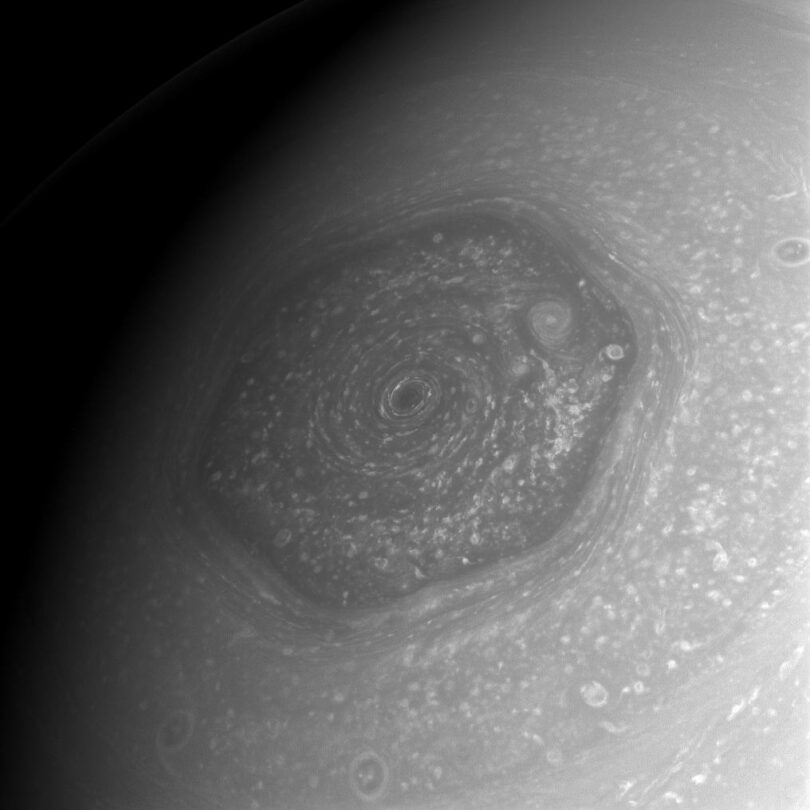Saturn, the sixth planet from the Sun, has long captivated astronomers with its extensive ring system and unique atmospheric phenomena.
One such phenomenon is the hexagon-shaped storm located at its north pole, an atmospheric mystery that has puzzled scientists since its discovery.
The Voyager missions, operated by NASA in the early 1980s, were the first to identify this six-sided vortex, but it was the Cassini spacecraft that provided a closer examination, revealing intricate details about the shape and dynamic behavior of this extraordinary weather pattern.
The Saturnian hexagon stands out as a striking feature against the planet’s gaseous backdrop, with each of the sides nearly as wide as Earth.
The nature of this hexagon intrigues researchers as it remains stationary and retains its geometric shape while the surrounding atmospheric gases swirl chaotically.
A myriad of theories have arisen to explain its stability and longevity, with some suggesting that the phenomenon is a standing wave pattern, while others postulate it could be the result of specific gradient conditions in Saturn’s atmosphere.
Voyager
In the early 1980s, NASA’s Voyager spacecraft glimpsed Saturn’s northern hemisphere and revealed a hexagonal-shaped pattern encircling the planet’s north pole.
The data, which comprised detailed images and atmospheric observations, pointed to a large, six-sided storm. This striking feature, stretching approximately 25,000 kilometers wide, was unlike any atmospheric pattern observed on other planets.
Advancements by Cassini
Years following Voyager’s discoveries, the Cassini mission, a collaboration between NASA, the European Space Agency, and the Italian Space Agency, took a deeper look at Saturn’s hexagon.
With sophisticated instruments, Cassini’s spacecraft captured high-resolution thermal images and gathered extensive atmospheric data.
These observations enabled scientists to confirm the hexagon’s persistence through seasons and offered insights into its rotational dynamics and longevity.
The sheer volume of data from the Cassini spacecraft revolutionized our comprehension of Saturn’s atmosphere and complex weather systems.
Nature and Dynamics of the Hexagon
The perplexing hexagon at Saturn’s north pole is a meteorological phenomenon with dynamics that are both intricate and massive in scale.
It consists of a six-sided jet stream and atmospheric conditions that are unique to this gas giant.
Atmospheric Conditions and Jet Streams
Saturn’s north pole hosts a persistently stable hexagonal pattern which endures in the upper atmosphere. This polygonal shape arises from high-speed zonal jets that encircle the pole. Differential wind speeds and stability in the atmosphere generate vortices around the pole, solidifying the hexagon’s presence. Contrasts in wind velocities contribute to a wave-like motion, coalescing into the distinct six-sided structure. These forceful winds are a defining feature of Saturn’s atmospheric behavior, presenting a turbulent yet organized system.
Hexagonal Storm Structure
The hexagon storm represents an extraordinary example of a polar cyclone. Unlike chaotic storms seen elsewhere, this vortex maintains a remarkably symmetrical form. The structure is towering, with the hexagon observable in cloud formations spanning a vast vertical range. The dynamics of this storm system suggest a high degree of interaction between multiple atmospheric layers, possibly affecting weather patterns beyond the immediate vicinity of the north pole. Its angular aesthetic defies typical cyclone appearances and continues to intrigue as a prime example of Saturnian meteorological phenomena.
Theories and Hypotheses
The mysterious hexagon on Saturn is a subject of significant interest and research among astronomers. To explain this phenomenon, different theories have emerged based on observations and simulations, focusing on meteorological and physical processes possibly occurring on this gas giant.
Deep Thermal Convection Theory
One prominent theory suggests that deep thermal convection, a process involving heat transfer within Saturn’s atmosphere, plays a crucial role in the formation of the hexagon. This hypothesis posits that the temperature differential between the warmer lower layers of Saturn’s atmosphere and the colder outer layers generates a columnar convective motion. When projected onto a horizontal plane at the gas giant’s north pole, this motion possibly results in the peculiar hexagonal flow pattern.
Researchers have used 3D simulation models to support the deep thermal convection theory. Simulations have shown that under certain conditions, convection can reproduce a hexagonal pattern similar to the one observed on Saturn. This lends weight to the hypothesis that deep thermal convection is responsible for the appearance of the hexagonal storm system on Saturn.
Self-Organization and Flow Patterns
Another approach to explaining Saturn’s hexagon is the concept of turbulent self-organization. This hypothesis involves the self-organization of atmospheric vortices under specific conditions. Such flow patterns can organize themselves into stable geometric shapes in response to the planet’s rotation and atmospheric conditions.
Astronomer David A. Godfrey has speculated that the hexagonal shape could be a manifestation of a long-lasting wave pattern from the jet stream flow at Saturn’s north pole. The geometric pattern could be due to a gradient in the speed of the atmospheric winds, with the slower-moving air inside the hexagon and faster-moving air outside of it.
Each theory offers a plausible explanation for the hexagonal phenomenon, highlighting the complexity of weather systems on gas giants. Both suggest that the remarkable structure could be a naturally occurring, self-sustaining feature resulting from the dynamics of Saturn’s turbulent and gaseous outer layers.
Saturn’s Place in the Solar System
In our Solar System, Saturn stands out with its distinctive features and dynamics that differ significantly from those on Earth, including the unique hexagonal storm at its north pole and its complex ring system.
Comparison With Earth’s Phenomena
Saturn, the sixth planet from the Sun, showcases characteristics unlike any found on Earth. As a gas giant, it lacks a solid surface, making the phenomena observed on this giant planet fundamentally different from terrestrial occurrences. While Earth experiences hurricanes, Saturn’s weather patterns occur within the upper layers of hydrogen and helium, and the planet’s immense size contributes to meteorological features on a much grander scale.
Impact of Saturn’s Rings and Rotation
The iconic icy rings of Saturn are not only a marvel to observe but also play a role in the planet’s atmospheric conditions. These rings, composed of countless small particles, reflect the interplay of Saturn’s gravitational field and its orbiting debris. Saturn’s fast rotation—a day on Saturn lasts just over 10.5 hours—contributes to its oblate shape and influences the wind speeds within the upper atmosphere, distinguishing its meteorological phenomena from those on Earth. The immense angular momentum of Saturn, combined with its rapid rotation, is also thought to affect the internal heat distribution, leading to planet cooling processes unlike those found on Earth.
As researchers continue to study this distant giant, the complexities of Saturn’s place within the solar system come into sharper focus, offering insights into the diversity of planetary systems and the forces that govern them.
Imaging and Analysis Techniques
The study of Saturn’s hexagon has been greatly advanced by sophisticated imaging and analysis techniques. These methods have provided a clearer understanding of the planet’s atmosphere and the mechanics behind this unique six-sided storm.
Cassini’s Photography and Data Collection
The Cassini spacecraft played a crucial role in capturing detailed images of Saturn’s hexagonal cloud pattern. Utilizing a range of color filters and sophisticated imaging systems, Cassini provided high-resolution photos that revealed the intricate structures within the storm. The spacecraft’s comprehensive data collection included visual, infrared, and ultraviolet light observations, offering researchers a multilayered perspective of Saturn’s dynamic atmosphere.
Infrared and Spectral Analysis
Infrared imagery and spectral analysis have been instrumental in examining Saturn’s hexagonal feature. Using these techniques, scientists can obtain thermal images that show the temperature distribution across the storm, highlighting how the polygonal shape interacts with Saturn’s surrounding atmosphere. This information is vital for creating models that simulate Saturn’s complex atmospheric behaviors in the laboratory setting.


